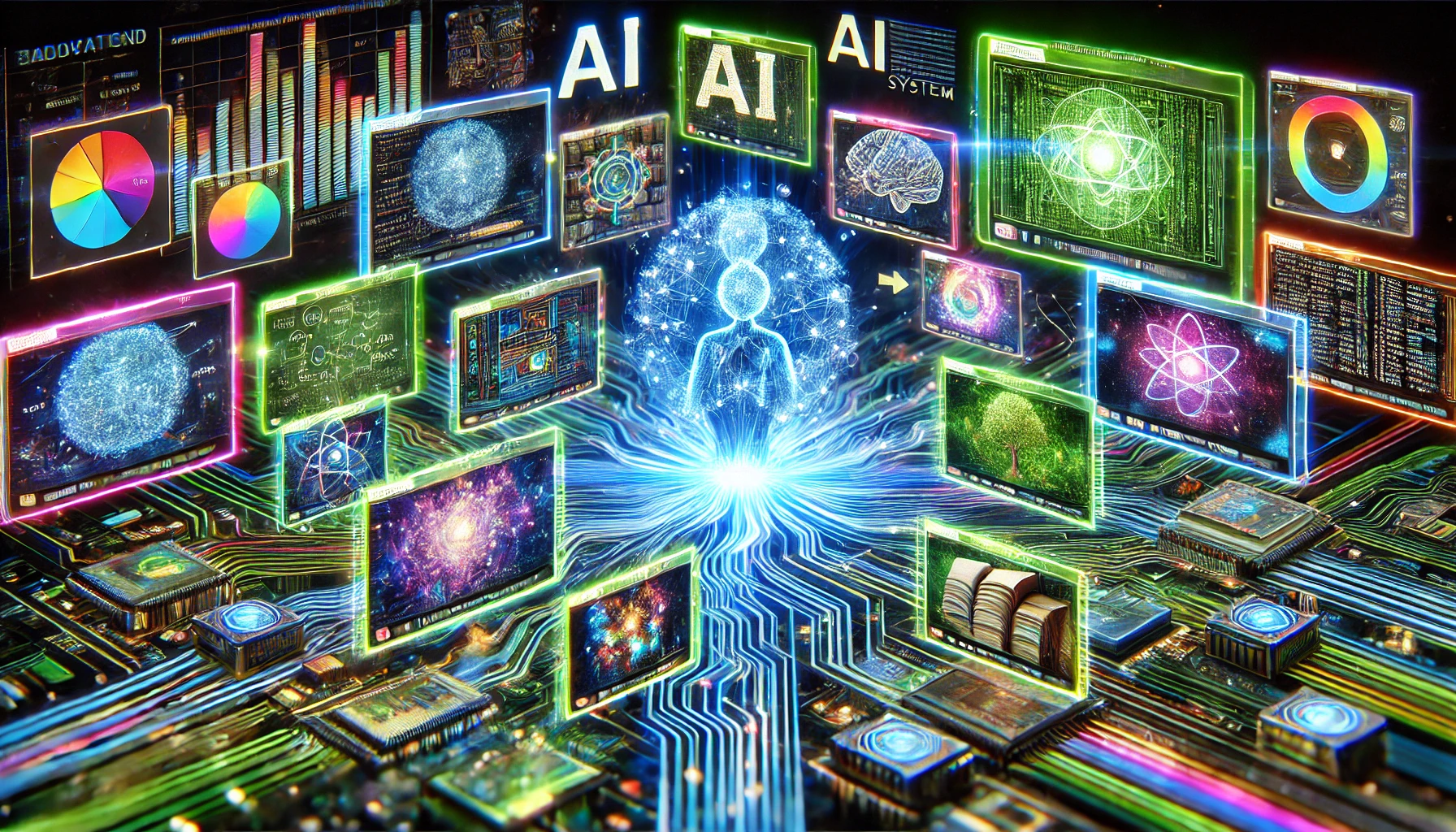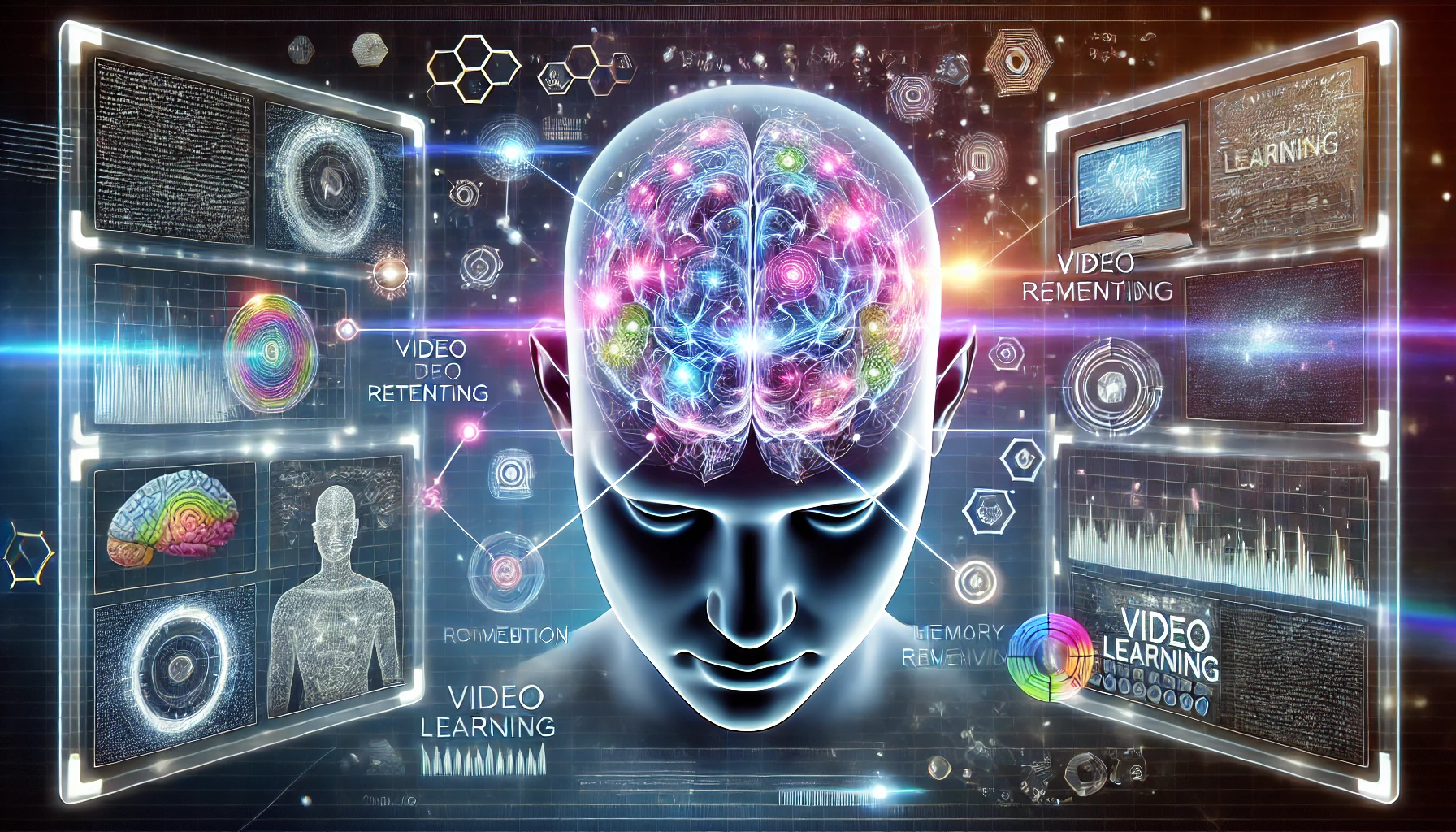The What, Why, and How of Savantz.Ai’s Innovative, AI-Powered Approach to Educational Video
August 7, 2024
Dorine Rivers, PhD, PMP
Savantz AI, Founder & CEO
The Inflection Point: Video in Education
Educational video is a big field, covering everything from showing documentaries during school hours to flipped classrooms with prerecorded online lectures. It benefits students, teachers, and educational institutions and is increasingly vital both as a means of delivering content and as a mode of instruction.
Two years ago, a survey of almost 700 educators in 10 countries concluded that,
We’re at a clear inflection point for education as the world works its way out of the pandemic and establishes a new normal. Video is becoming the preferred teaching medium worldwide, and 97% of education professionals say that video is essential to students’ academic experiences.
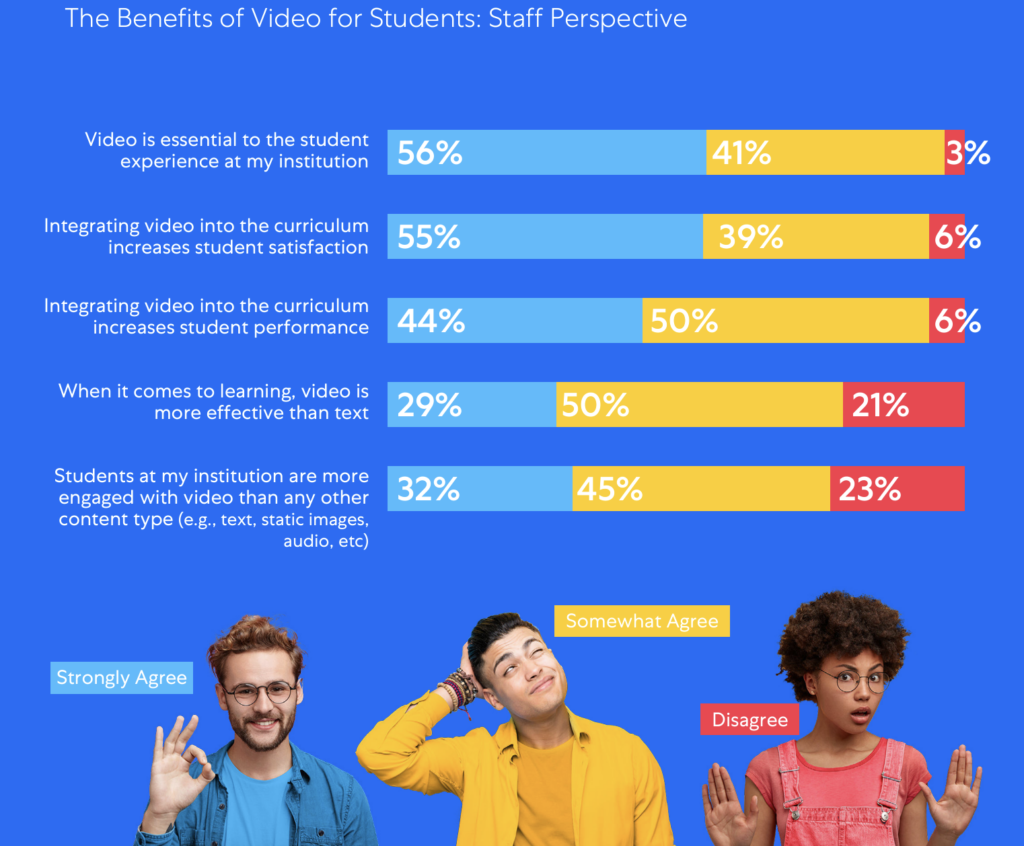
Figure 1. Image and data from Kaltura. 97% of educational staff agree that video is “essential,” and 94% agree that it increases student performance and satisfaction.
The importance of video—massively amplified by the pandemic-induced global switch to online learning—has only increased since then. And no wonder: it offers staggering advantages with costs that keep dropping and new tools, options, and accommodations available every year.
According to the best and most recent research, compared to traditional text-based learning materials, video is:
- Better at holding students’ attention
- More emotionally, intellectually, and visually engaging
- A much richer, multisensory experience
- Better able to meet the needs of students with disabilities or learning challenges
- Easier to remember and more effective for long-term learning
- More familiar and approachable for generations growing up online
- Better at stimulating discussion and conversation
- A more flexible medium for presenting information, making it easier to convey complex relationships and abstract ideas
- Radically varied and endlessly abundant, allowing for the direct sharing of experiences, perspectives, and stories
- Way more fun
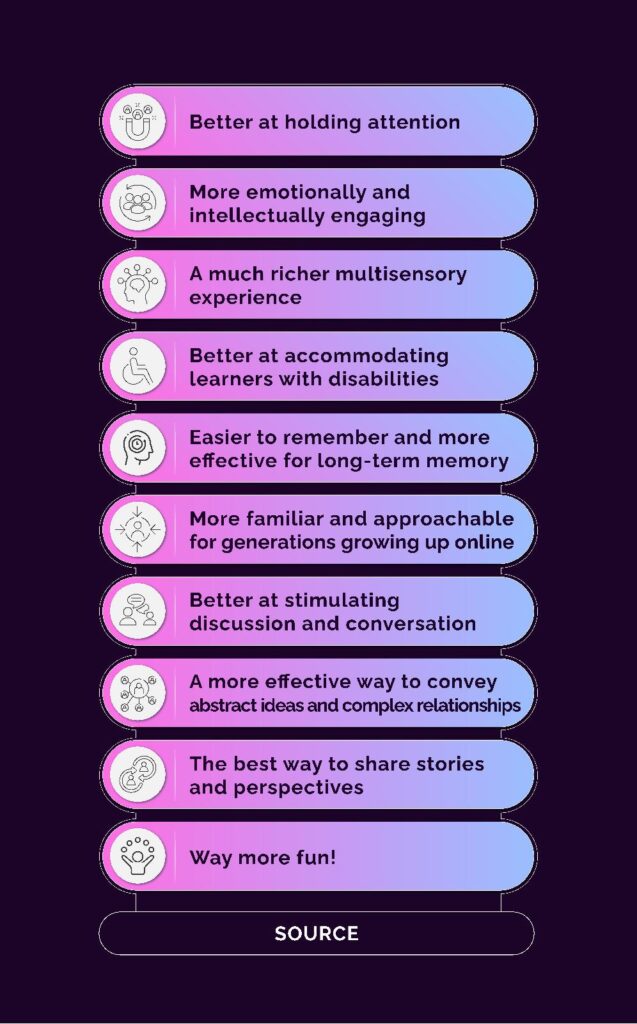
Figure 2. Major benefits of video education, according to a SAGE White Paper.
This page will get into some of the science behind these benefits (and we discuss them regularly over on our blog). First, though: what is generative video for education?
The Big Idea: AI-Generated Video
Educational video was first developed as a military technology to help train soldiers for World War II. Even twenty years ago, it remained very firmly stuck in the world of slow-moving physical media, often taking the form of a VHS tape and a CRT television on a rolling shelf. A decade back, it had evolved into low-resolution video files painstakingly uploaded to Moodle or Blackboard, often with semi-inaudible sound and illegible text. Corporate trainings have relied on similar technologies for instructional and training and compliance videos since the 1960s.
Improvements in streaming took care of the clunkiness and quality, but one major bottleneck remained: sourcing content. Educators could purchase dedicated educational material but struggled with inadequate public education budgets, or they could produce their own video, or find suitable content online, both hit-or-miss strategies that require significant time and effort.
In the corporate world, training and development videos were expensive to make and often had to be discarded as requirements changed or the company’s needs shifted.
Those problems are behind us. With the advent of generative Artificial Intelligence (AI) capable of creating new material on demand, educational video is freed from the constraints of traditional time-intensive filmmaking in much the way streaming freed it from the constraints of physical media.
Today, educational video has the potential to be a new and transformative method of instruction, a powerful pedagogical instrument allowing any subject to be presented in a way that best meets the needs of specific students and particular classrooms. The ease and flexibility of creating content means that short-form video can be added to a lesson plan last-minute, and whole curriculums can have rich, integrated video support.
The Savantz.ai platform exists to make those possibilities real. It is an aid for teachers, and an investment for school systems, and, for students, it’s a darn good time. Top global universities like MIT and Cornell are focusing in on educational applications of generative AI. We’re right there alongside them, working right at the knowledge horizon of the new field of AI-powered educational video.
The Neuroscience of Educational Video
The power of educational video lies in its multimodal, multisensory, emotionally and socially appealing delivery of information. As compared to learning with paper-based materials, video gives “multiple entry points” for learners of different styles, with different preferences and types of intelligence, and who might not otherwise be motivated to engage with the lesson.
The science behind that power is fascinating. Educational video’s effectiveness is rooted in the importance of memory. In classrooms, in conference halls, out in the field—wherever an instructor, coach, or teacher is trying to pass on knowledge—they rely on the neurological systems of working memory and memory consolidation, procedural and episodic memory of events and declarative memory of facts and things.
Although these mechanisms are spread out across brain regions and rely on networks comprising billions of neurons, we understand them just well enough for teaching techniques and educational technology to capitalize on our understanding, in effect “hacking” the human brain to make learning more effective.

Figure 3. The brain forming and accessing a new memory. From Raslau et al.
Right at the core of all these efforts is the way we pay attention. Attention is the psychological process that selects which information makes it into working memory. It’s the word we use to describe underlying neural engagement, or in other words, paying attention is what it looks and feels like when the electrochemical activity in our brain is coordinating with the parts of the world we’re trying to learn from.
Here’s why that matters. The fundamental mechanism of memory consolidation—the formation of long-term memories that can stick around after a lesson is over—depends on getting neurons to “fire together” or activate almost simultaneously, strengthening their connection via a process called “long-term potentiation (LTP).” Attention helps that happen, and helps it happen in a way that ensures the neurological changes going on are relevant to the learning materials at hand.
(Any neuroscientists in the audience will have noticed that we’re over-simplifying here. There are many mechanisms that underlie different kinds of memory formation, modification, reinforcement, and retrieval, and our understanding of them changes consistently. Attention is important to many of these mechanisms, but we’re highlighting LTP here both because it’s the best-studied and because it’s the easiest to grasp. Keep an eye on our blog for more discussions of memory, learning, and brain science in the future!)
There are several strands of evidence backing up these ideas, two of which are very direct. One involves the prefrontal cortex (PFC), a brain region associated with rational decision-making and conscious control of behavior. The PFC has certain frequencies of brainwaves that are vital to “enhancing the neuronal representation of attended sensory input,” or making sure your brain registers the thing you’re trying to pay attention to, and brainwaves that trigger memory consolidation in the hippocampus.
Another key piece of evidence is that if you apply electrical stimulation to the scalp, more or less simulating brain activity of the same kind as those brainwaves we just mentioned, you can trigger very similar improvements in both selective attention and memory formation.
A third piece of evidence comes from neurological experiments of neural engagement itself. These studies track brainwaves as participants complete various sorts of everyday activities. A pathbreaking study at NYU six years ago did this with a simple learning task and measured how similar each person’s brainwaves were to the average for the whole group. Because the only thing the participants had in common was the material they were learning, the similarity in brainwaves was a good indicator of how closely each person was paying attention. It also turned out to predict how well each participant remembered the material afterwards, with an r of 0.57 for the correlation between higher neural engagement and higher performance on a test about video content given after watching.

Figure 4. Attention during different classroom activities, measured as normalized alpha power from EEG recordings.
All of this is reinforced by studies of video itself, which turns out to be uniquely good at hijacking our attention. As compared to lectures or text, video content triggers a huge uptick in brainwaves associated with paying attention.
Add all this up and you get a clear conclusion: if you can get learners to pay attention, they’ll remember the lesson. And nothing captures and holds our attention quite like an engaging video. By helping students pay attention and stimulating neural engagement, educational video super-powers the formation of memory.
Just How Well Does Educational Video Work?
The brain science is backed up by the numbers on educational outcomes: video just works. The numbers vary for reasons we’ll get into, but an illustrative study found that the video version of a story, as compared to the text version, produced about 30% better recall of the basic facts.
Here’s one example of the power of video. The Corporation for Public Broadcasting does regular surveys on educational video. They reported that about 70% of teachers who use video consistently say it both makes students remember the material better and increases their motivation. And that was twenty years ago.
In fact, we already had persuasive studies in the late ‘80s showing that using video to present educational materials made it easier to remember. That line of research continued through the ‘90s and then exploded along with the rise of e-learning.
One recent meta-analysis looked at almost 100 studies of educational videos for college students. They calculate that replacing text with video has a general positive effect, but the big winner was adding supplemental video—they figure that 88% of the time, supplemental video increases how much students learn.
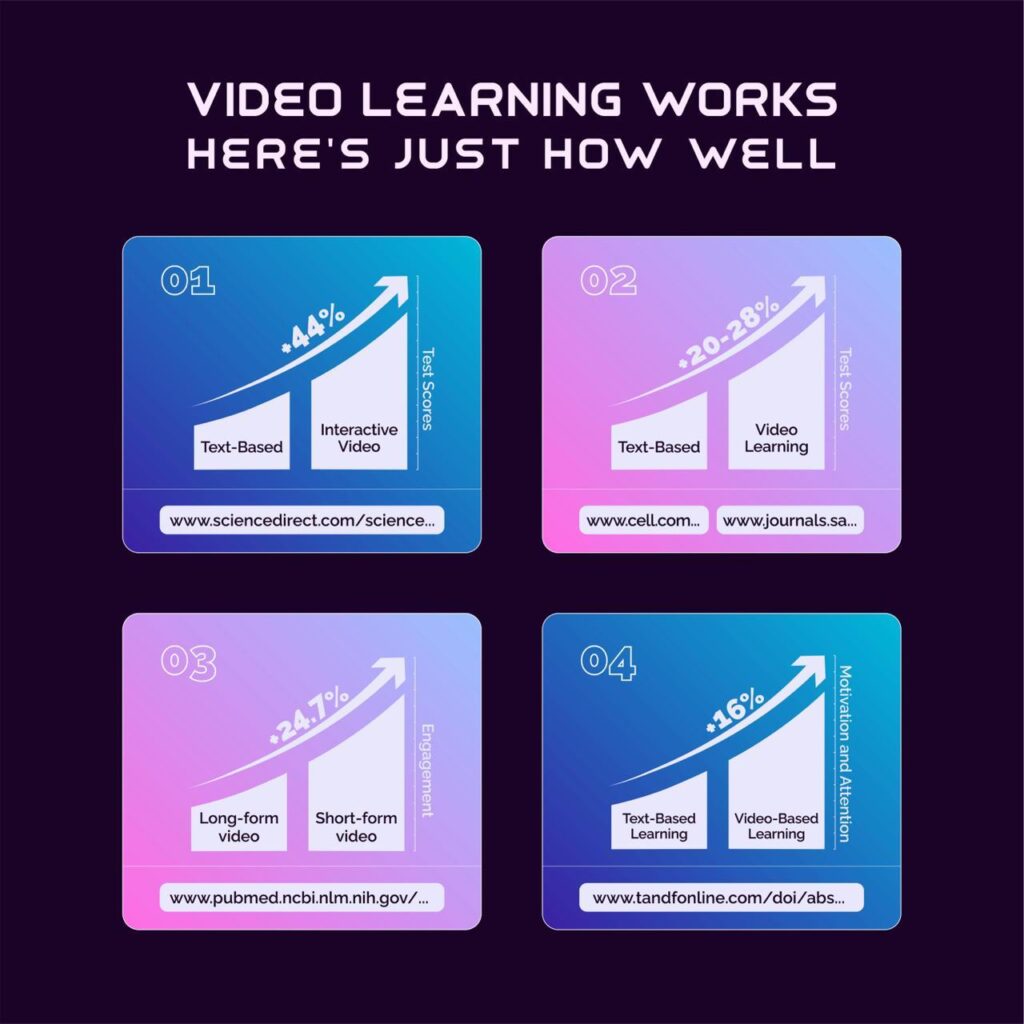
There’s no real consensus on the hard numbers; exactly how much video boosts learning depends on the type of video used, the class and teacher using them, the curriculum, and even the type of educational program.
There are some very consistent themes, however. Studies in a wide variety of contexts, using very different learning materials and topics, find that educational video boosts test scores and retention. One study found that video improved learning outcomes by 44% over non-video materials; others have reported test scores rising by 20% to 28% when comparing video to text-based instruction.
Some of the best data comes from medical schools:
- One simple study compared printed handouts to instructional videos. Scores for the handout did improve, ending at about 62% correct, but scores for instructional video were 93%, more than 30% higher.
- Another medical school conducted a tablet study. Students with text-based learning materials saw their scores roughly double after reading about the subject they were being tested on, going from scores of around 4 to scores of around 8. By contrast, students who instead learned from tablets loaded with instructional videos saw their scores jump from 5.9 to 20.6, an increase of almost 250%!
- A skills-training study compared learning a new examination technique via traditional methods versus learning from instructional videos. Only 40% of traditionally taught students learned one skill, and only 20% picked up the second. For video learners, 92% and 83% had satisfactory skills after training.
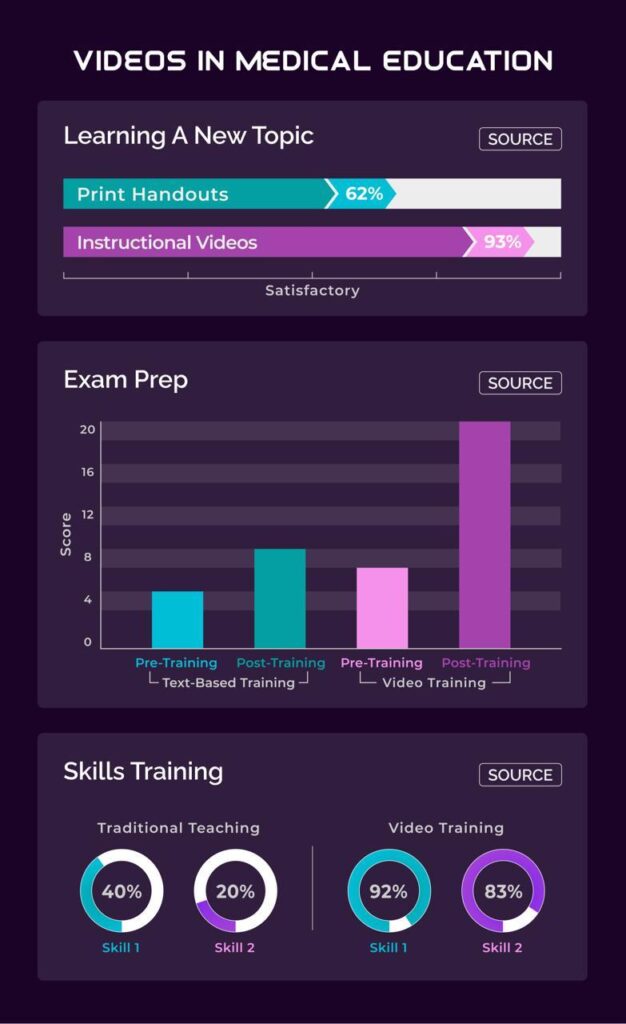
Meanwhile, more qualitatively oriented studies report marked improvements in student satisfaction and motivation to learn.
In one big multi-national survey from Kaltura, almost 75% of educational staff said that video engages their students more than text-based content and that students are more likely to interact with course materials when video is used. Additionally, 94% agreed that video increases student satisfaction and thought it improved student learning outcomes overall.
What Makes a Good Video?
According to Vanderbilt University’s Center for Teaching, effective educational video has three key traits:
- Keeps cognitive load manageable
- Makes smart use of “non-cognitive” elements to boost engagement
- Includes features that promote active learning
Each of these strategies will be familiar to educators. What’s important about them now is the ease with which AI-powered video content can be tailored to meet those goals.
The idea of cognitive load is roughly this: we have limited mental capacity. Incoming information—sights, sounds, and so on—is received and processed in the sensory cortex. From there, we choose which bits of it seem important by paying attention to certain parts of what’s going on around us, and that selection process moves our chosen information into short-term “working” memory.
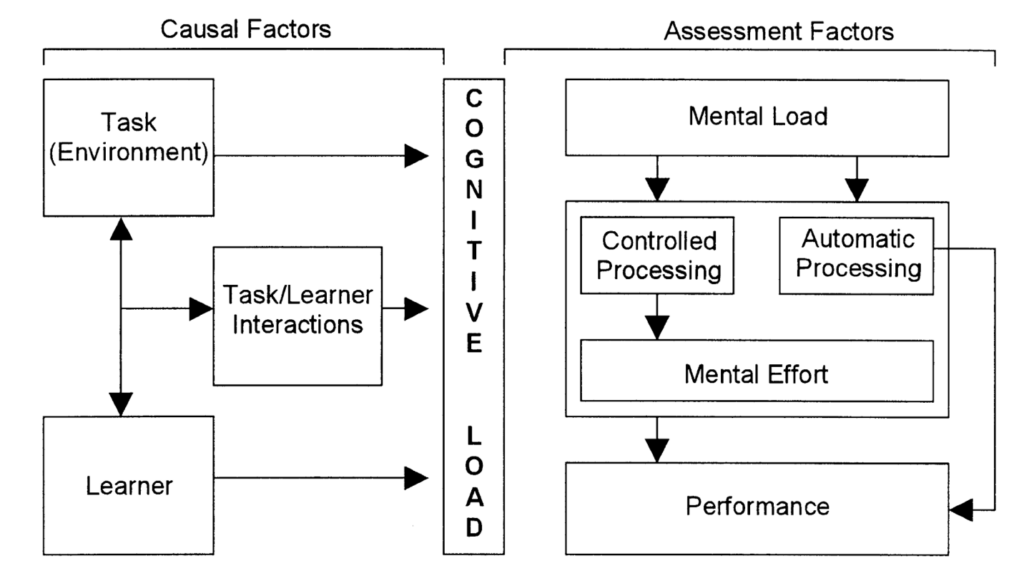
Figure 5. The factors affecting cognitive load. From Kirschner (2002).
Working memory only holds a small amount of information, but our various kinds of long-term memory have tremendous capacity. Cognitive load theory says that if we want to learn something, it has to be presented in such a way that we can keep both the information itself and the important context in working memory long enough to build more enduring long-term memories.
In practical terms, that means educational video needs to be well-paced, high on essential information, and low on extraneous information—stuff that’s interesting but doesn’t contribute to the key learning outcome.
Then there’s engagement. You want to design, structure, and present videos in ways that make them more likely to be watched. Research on videos in online courses gives crucial guidelines:
- Keep it short. Videos longer than 9 minutes lose half their engagement, and videos longer than 12 minutes lose up to 80%.
- Make the style personal. Narration should be relaxed and conversational to help students feel a sense of social connection.
- Bring the energy. Anyone talking in the video needs to talk relatively quickly and with enthusiasm.
- Know your audience. Video that is just recorded lecture isn’t very engaging—the speaker is working hard to engage someone, they just aren’t the people watching the video.
- Match medium and content. Narrative video works well when the narrator is shown; math instructions need diagrams and equations.
- Don’t skimp on variety. For instance, mix first- and third-person perspectives.
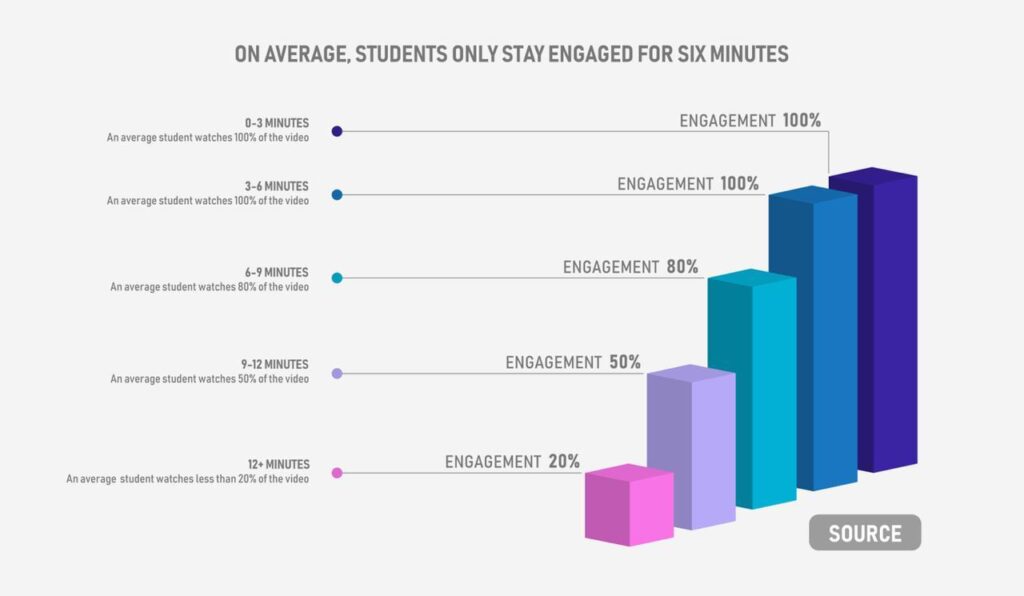
Promoting active learning is a little more flexible, since the nature of generative video creates so many new possibilities. Some established techniques still work, though, like making the video part of a homework assignment or giving students questions to think about before they watch it. It’s also critical to give students control over video playback (pause/play, speed, volume, etc.).
Recent innovation, however, allows for more interaction. Interactive chat, questions and quizzes (with feedback!) integrated into videos, and other new technologies make it possible to preserve all the features that make videos fun while also getting students more involved.
So, Why AI?
The answer to that question is short and sweet: AI is the perfect tool for making engaging videos with minimal cognitive load and extremely high levels of interaction. The same kinds of machine learning that power Savantz.ai are already used for some forms of interactive video, but what we’ve done goes far beyond the relatively narrow applications already out there.
Savantz.ai is about video content that meets your students where they are. Learning materials that educate and edify, yes, but that are also uniquely memorable, leading to unprecedented learning and retention for students of all ages.
Get in touch with the sales team.

